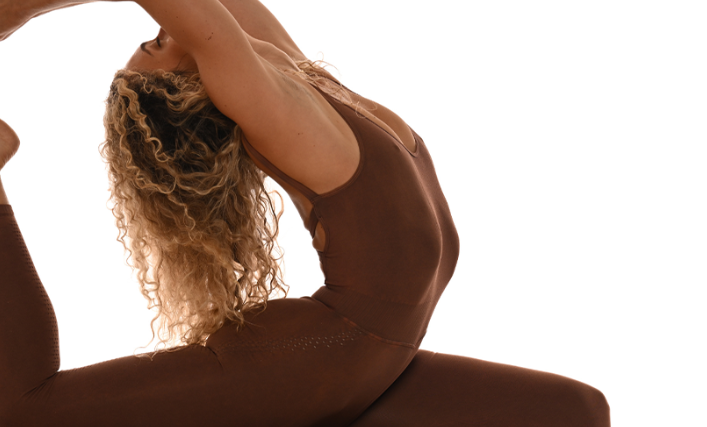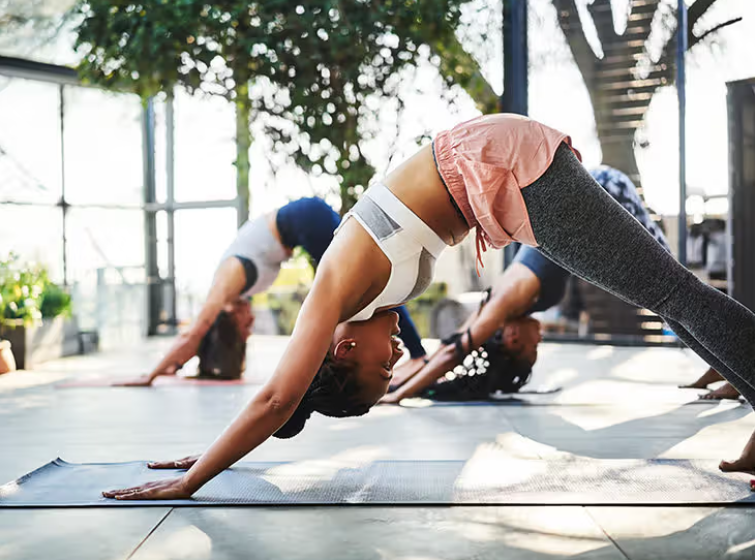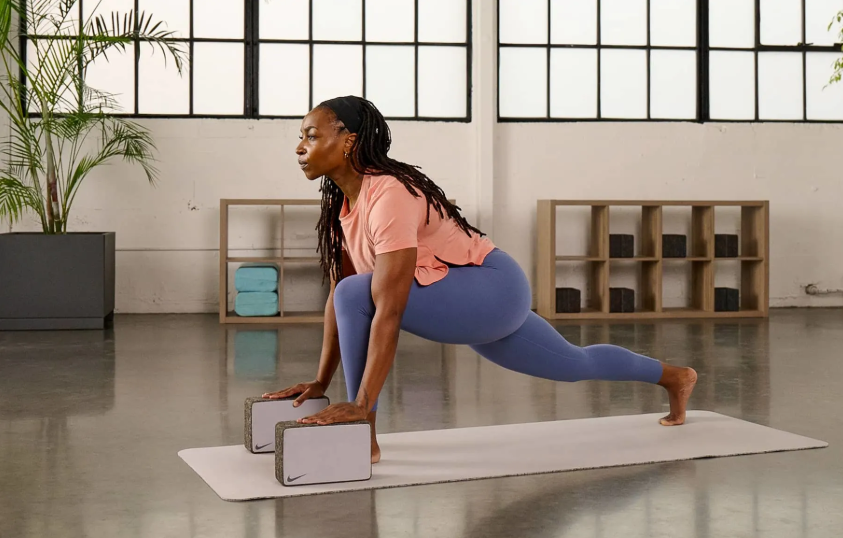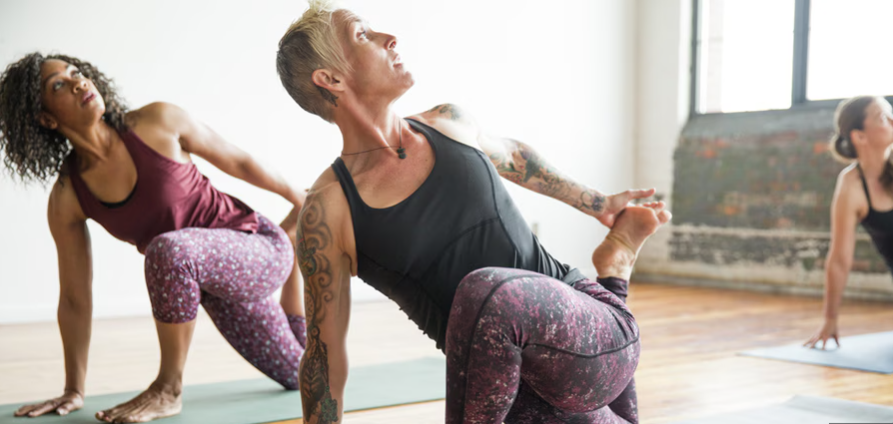
Stretches Tight Muscles: Many cases of back pain are caused by tight muscles, particularly in the hips, hamstrings, and lower back. Yoga stretches these areas, releasing tension and improving flexibility.
Strengthens Core and Back Muscles: A weak core or back can contribute to back pain. Yoga strengthens the muscles that support the spine, improving posture and stability.
Improves Posture: Poor posture, especially from sitting for long periods, can strain the back. Yoga helps correct postural imbalances by encouraging proper alignment and strengthening the muscles that support good posture.
Promotes Relaxation: Stress and tension can exacerbate back pain. Yoga’s focus on mindfulness and breath control helps calm the mind and reduce stress, which can alleviate muscle tension.

Cat-Cow Pose (Marjaryasana-Bitilasana): This gentle flow between two poses helps stretch and mobilize the spine.
How to Do It: Start on your hands and knees. Inhale as you drop your belly toward the floor, lifting your head and tailbone (Cow Pose). Exhale as you round your spine toward the ceiling, tucking your chin and pelvis (Cat Pose). Repeat this flow for several breaths.
Benefits: Cat-Cow stretches and warms up the spine, releasing tension in the back and neck.
Child’s Pose (Balasana): A restful pose that gently stretches the lower back, hips, and thighs.
How to Do It: Kneel on the floor with your big toes touching and knees spread apart. Sit back on your heels and stretch your arms forward, resting your forehead on the mat.
Benefits: Child’s Pose provides a gentle stretch for the lower back while promoting relaxation and relieving stress.
Sphinx Pose (Salamba Bhujangasana): A gentle backbend that stretches the spine and strengthens the lower back.
How to Do It: Lie on your stomach with your legs extended and elbows directly under your shoulders. Press your forearms into the mat as you lift your chest and gently arch your upper back.
Benefits: Sphinx Pose helps strengthen the lower back and stretches the spine, promoting healthy posture.
Seated Forward Bend (Paschimottanasana): A seated pose that stretches the hamstrings and lower back.
How to Do It: Sit with your legs extended in front of you. Inhale to lengthen your spine, then exhale as you fold forward, reaching for your feet or shins. Keep your back as flat as possible to avoid straining the lower back.
Benefits: This pose stretches the hamstrings, which can reduce tension in the lower back, and promotes spinal flexibility.
Bridge Pose (Setu Bandhasana): A gentle backbend that strengthens the glutes, hamstrings, and lower back.
How to Do It: Lie on your back with your knees bent and feet hip-width apart. Press your feet into the floor and lift your hips toward the ceiling, keeping your shoulders grounded.
Benefits: Bridge Pose strengthens the muscles that support the spine, particularly the glutes and lower back, while gently stretching the chest and neck.
Supine Twist (Supta Matsyendrasana): A reclining twist that stretches the spine and releases tension in the lower back.
How to Do It: Lie on your back with your arms extended out to the sides. Bring your knees to your chest and then lower them to one side, keeping your shoulders grounded. Hold for several breaths, then switch sides.
Benefits: Twisting poses help release tension in the lower back and spine, promoting flexibility and relaxation.
Pigeon Pose (Eka Pada Rajakapotasana): A deep hip opener that can relieve lower back pain caused by tight hips or sciatica.
How to Do It: From a Downward Dog position, bring one knee forward and place it behind your wrist, with your shin angled across the mat. Extend the other leg straight back, and lower your torso over your front leg.
Benefits: Pigeon Pose helps open the hips and stretch the glutes, which can reduce tension in the lower back and alleviate sciatica.

Diaphragmatic Breathing: This technique encourages deep, slow breaths that engage the diaphragm and promote relaxation.
How to Do It: Lie on your back or sit comfortably. Place one hand on your belly and the other on your chest. Inhale deeply through your nose, allowing your belly to rise, and exhale slowly, letting your belly fall. Repeat for several minutes.
Benefits: Deep breathing helps reduce tension in the muscles and promotes relaxation, which can alleviate back pain.
4-7-8 Breathing: A simple breath pattern that helps calm the mind and body.
How to Do It: Inhale through your nose for 4 counts, hold the breath for 7 counts, and exhale through your mouth for 8 counts. Repeat for 4-6 rounds.
Benefits: This technique helps activate the parasympathetic nervous system, promoting relaxation and reducing stress-related back tension.

Focus on Alignment: Proper alignment is key to preventing further injury. Pay attention to your body’s position in each pose and avoid rounding the spine or forcing yourself into deep stretches.
Use Props: Yoga blocks, straps, and blankets can help modify poses to suit your body’s needs. For example, placing a block under your hips in Pigeon Pose can reduce strain on the lower back.
Move Slowly: Take your time moving in and out of poses, especially if you’re dealing with acute back pain. Slow, mindful movements reduce the risk of strain or injury.
Avoid Overstretching: Stretching too deeply can worsen back pain. Focus on gentle stretches that feel comfortable and avoid pushing yourself beyond your limits.
Consult a Professional: If you have a serious back condition, consult with a healthcare professional or a certified yoga instructor who specializes in back care before starting a new practice.

Practice Consistently: Aim to practice yoga 3-4 times a week to build strength, flexibility, and resilience in your back muscles.
Listen to Your Body: If you’re feeling sore or tight, opt for gentle, restorative poses. On days when you feel stronger, you can incorporate more dynamic poses to build strength.
Combine Yoga with Other Forms of Movement: In addition to yoga, incorporate other forms of low-impact exercise, like walking or swimming, to support your back health.
Final Thoughts
Yoga is a gentle and effective way to relieve back pain, strengthen the muscles that support the spine, and improve overall mobility. By practicing these poses regularly and incorporating mindful breathing, you can ease discomfort, reduce tension, and promote long-term back health. Remember to listen to your body and adjust your practice as needed to ensure you’re moving in a way that supports healing and well-being.